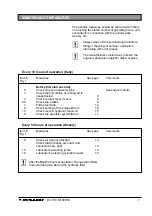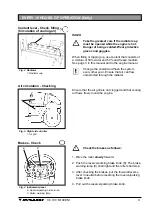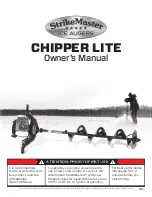
15
CC 100 M100EN1
Battery Checking
the electrolyte level
Battery cells
Never use an open flame when checking
the battery. The electrolyte emits explosive
gas while the alternator is charging.
1. Open the engine cover fully.
2. Wipe the top of the battery.
Wear protective goggles. The battery
contains corrosive acid. Flush with water
if acid comes in contact with the body.
3. Take off the cell caps and check that electrolyte level
is about 10 mm (1/2 in) above the plates. Check the
level of all cells. Top up with distilled water as required
to the correct level. If ambient temperature is below
freezing, the engine should be run for a while after
topping up with distilled water, ie, there is otherwise a
risk that the battery fluid will freeze.
4. Make sure the venting holes in the cell caps are not
clogged. Refit the caps.
5. Battery terminals must be clean and well tightened.
Clean the terminals if corroded and grease them
with acid-free Vaseline.
Always release the negative cable first when
disconnecting the battery.
When connecting the battery, always fit the
positive cable first.
Dispose of the old battery properly when
replacing it. The battery contains lead which is
detrimental to the environment.
Fig. 18 Electrolyte level in battery
1. Cell cap
2. Electrolyte level
3. Plate
EVERY 250 HOURS OF OPERATION (Monthly)
Fig. 16 Engine compartment
1. Hydraulic fluid cooler
Hydraulic fluid cooler
Checking - Cleaning
1
1
Fig. 17 Battery shelf
1. Battery
Ensure that the flow of air through the cooler is not
obstructed.
Clean a dirty cooler using compressed air or a high-
pressure washing unit.
Blow or wash the cooler in the opposite direction to the
normal flow of cooling air.
Take care when using a high-pressure
washing unit, hold the nozzle at a safe
distance from the cooler.
Wear protective goggles when working with
compressed air or high-pressure wash.
Summary of Contents for CC100
Page 2: ......













































